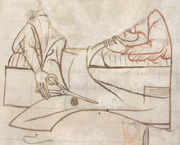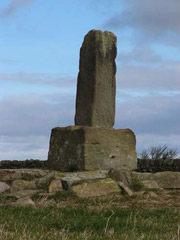 |
 |
 |
 |
 |
 |
 |
|
Fountains Abbey: History
Fountains Abbey: Buildings
|
Sheep farming (18/33) Even the monks of the
Cistercian Order … were
taxed and The Yorkshire Cistercians were renowned for their sheep farming. This was integral to the Cistercian economy, for sheep not only provided wool, which could be used to make clothing and blankets for the community, or else sold, but were important for the manufacture of butter and cheese. Furthermore, parchment and blankets could be made from sheep skins.(75) The mid-fifteenth century ‘Memorandum Book’ records that Robert Glover of Ripley who, not surprisingly, sold leather and gloves, purchased sheepskins from the abbey.(76) Fountains was at one time the leading producer and exporter of Cistercian wool in the country, and its seventy-six sacks topped the list of wool producers in an Italian account of c. 1300. It has been estimated that the community must have had at this time c. 18,000 sheep.(77) Fountains thus required extensive tracts of pasture lands to graze its flocks. The sheep were moved between high and low pastures in accordance with the seasons. For example, the limestone uplands of Craven were used for summer grazing and the lower grounds of Bewerley for wintering; the wether flock that grazed at Bordley Hall in the summer was wintered at Braisty Woods, and the flock wintered at Bolstershaw moved to Darnbrook House in the warmer months.(78) The stretch of land from Malham Moor to Kilnsey grange was probably Fountains’ most important summer pasture, and the community had a number of sheepfarms [bercaries] on the uplands here, with their associated pastures and enclosed meadows.(79) The Augustinian priory of Bolton also had lands here, and the two communities engaged in disputes over rights in the thirteenth century.(80) [What was a sheepcote ? - Read more] Fountains
was granted pasture rights for three hundred sheep at Sawley, and
was also permitted to take fern for litter and for
roofing the sheepcote; as an added bonus the community could keep
the sheep manure produced here.(81) Whilst
this might seem a rather odd concession, manure was highly valued
and this would have been
considered a great boon. The base of a stone boundary cross, Lacon
Cross, survives at Sawley on the road from Fountains’ grange
at Warsill to the abbey. Crosses such as this were often erected
to indicate the road to travellers in bad weather.(82) |

